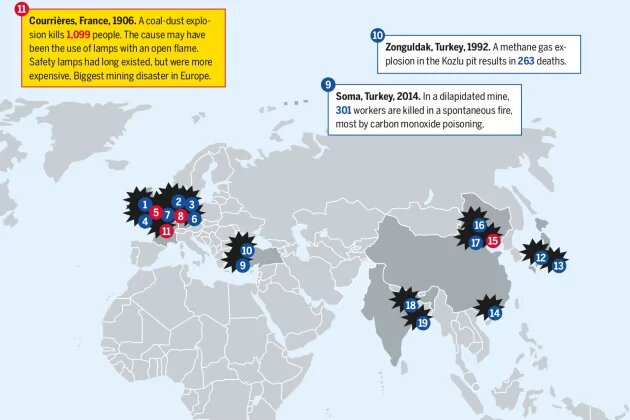
Although coal production is still on the rise, the sector is employing fewer people. Structural change has spread to all continents. Nevertheless, mining underground remains one of the most dangerous occupations worldwide. A chapter from the Coal Atlas.
In 2012, an estimated seven million people were employed in the coal industry, most of them in coal and lignite mining. That number is likely to be lower in 2015, with employment falling especially in China. The world’s largest coal producer is beginning to exploit its reserves more efficiently, however, it still needs many more workers than the United States, where modern equipment and optimized operations enable about 90,000 people to mine 0.9 billion tonnes, mainly in open-cast mines. In China, 5.7 million people are needed to dig out 3.7 billion tonnes, mainly from underground mines. In the United States 10,000 jobs were lost in 2013 alone, partly because the shale-gas boom has made coal production less profitable.
Fewer workers are needed in countries where productivity is rising quickly. For example, the Chinese government has closed thousands of small, inefficient mines. India also needs fewer workers to produce the same amount of coal. Coal India, the state-controlled producer, slimmed its employee rolls from 500,000 in 2005 to 350,000 in 2014. In the same period, its output rose by one-third. Moreover, both India and China have invested in Australian mines to boost their own supplies. These extensive coal imports mean that Australia is one of the few countries where employment in the coal sector was rising in the last decade.
The European Union is also cutting thousands of jobs every year. In 2008, 342,000 miners worked above and below ground; in 2013 the number was only 326,000. In the Czech Republic, which relies heavily on coal, there has been a decrease in employment in the coal sector. After a delay, structural change is now starting in Poland, which obtains most of its energy from coal. Britain has almost completed the transition: by 2016 only two pits will still be in operation, an old mine and a new one, both owned by their workforces.
Many mining accidents happen because the operators do not comply with the safety rules. Creator: Heinrich-Böll-Foundation.
This image is licensed under Creative Commons License.
In 1950, almost 540,000 people worked in Germany’s hard coal mines, and 360,000 of them underground. Today the figure is 12,100, and by 2018 there will be no miners underground. In the country’s lignite mines, the number of people directly employed in digging out the rock and transforming it into electricity has fallen from 130,000 in 1990 to 21,000 today.
While coal is declining as a source of employment around the world, renewables are growing in importance. In 2013, 6.5 million people were employed in this sector, 800,000 more than in the previous year, according to the International Renewable Energy Agency. This organization estimates that the coal and renewables sectors now employ a similar number of people worldwide. In Germany and the rest of the European Union, jobs in renewables have overtaken those in coal. In developing countries and emerging markets, however, employment figures cover only the coal industry itself, and do not include the related project development, transport and power-plant operations.
Despite such uncertainties, it is still possible to discern some trends. China is the leading power in renewable energy, employing 2.6 million people in 2013. Most jobs can be found in the production and installation of renewable-energy plants. Brazil follows with around 900,000 jobs, the USA with 600,000 and India with 400,000. Germany is fifth. Its employment in renewables has doubled since 2004; by 2013 it had reached 370,000. By comparison, the German lignite industry directly and indirectly employs 70,000 people.
Working conditions in the renewables sector are generally better than in coal, although the renewables still entails risks, as in the chemicals companies that make solar cells. But workers in coal mines are subject to much greater risk to life and limb. And to their lungs, where the coal dust settles causing chronic diseases. Mining accidents are often dramatic, claim many lives, and attract a lot of publicity. With 150 years of experience underground, the coal industry has a deep understanding of the risks, and has detailed regulations to prevent accidents. If accidents occur, they are usually due to safety precautions that have been ignored in order to save costs, to negligence, or to equipment failure.
The situation in China, which accounted for 80 percent of worldwide deaths in coal mining, is improving. The small mines that are being closed are also the most dangerous. In the 1990s, 5,000 to 7,000 miners died every year. In 2010 the figure was 2,400, and 930 in 2014, according to governmental data.
In the western world, the image of a miner is still one of a hard-working, soot-covered man. And indeed, in Europe or Canada – and also in India – women still account for less than 20 percent of the workforce. In the ex-socialist countries, however, more women go underground. In many parts of the world it is not easy for women to find work in the coal industry. And if they do land a job, they are usually paid less than men and have to fear sexual assault in the mine.
According to a Greenpeace study, the coal industry will shed another two to three million jobs by 2030. The renewables sector is growing fast enough to compensate for these losses. In 2014, the Ibbenbüren mine in Germany recruited 56 maintenance trainees. It was the last such hiring.